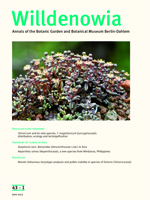This study elucidates cytological aspects of the complex genus Tamarix (Tamaricaceae). Chromosome counts were performed and meiotic behaviour recorded on 30 accessions belonging to 15 taxa and three putative hybrids from different parts of Iran. Karyotype data were analysed in five species. Both gametic and somatic chromosome counts showed most species are diploid (n = 12 and 2n = 24), but polyploidy (n = 24 and 2n = 36) was found in six taxa. All the studied species showed predominance of submetacentric chromosomes and a lower proportion of metacentric pairs. The chromosomes in studied species were found to be small with a mean chromosome length of 1.05 to 2.8 µm. Karyotype analyses showed different formulas from 12sm to 7m 5sm. Pollen viability in most species was more than 79 %, with low viability (28.5 %) observed only in T. cf. kermanensis, as a triploid taxon. This study reveals that polyploidy and hybridization could be important reasons for taxonomic complexity in Tamarix. Hybridization and the high chance of establishing hybrids by vegetative reproduction are major adaptive mechanisms in the successful growing, dispersal and probable rapid evolution of this genus in its native range. Furthermore these mechanisms could facilitate the spreading of Tamarix species outside their native range as aggressive invasive plants.
How to translate text using browser tools
9 June 2011
Meiotic behaviour, karyotype analyses and pollen viability in species of Tamarix (Tamaricaceae)
Nafiseh Samadi,
Seyed Mahmood Ghaffari,
Hossein Akhani

Willdenowia
Vol. 43 • No. 1
Jun 2013
Vol. 43 • No. 1
Jun 2013
Caryophyllales
Flora of Iran
hybridization
invasive plants
polyploidy
taxonomic complexity




